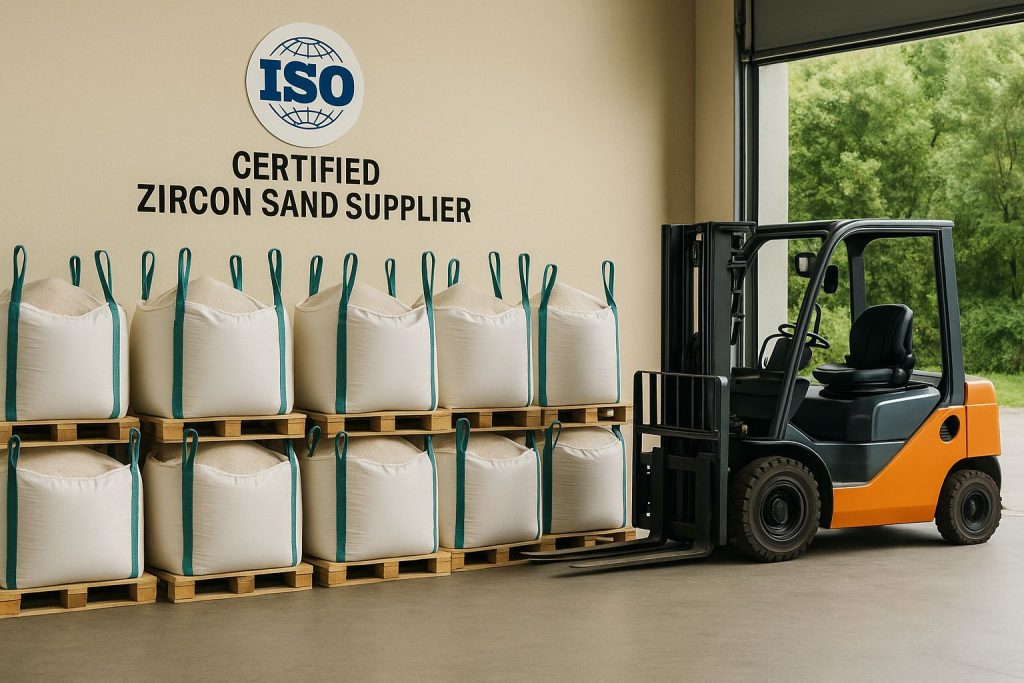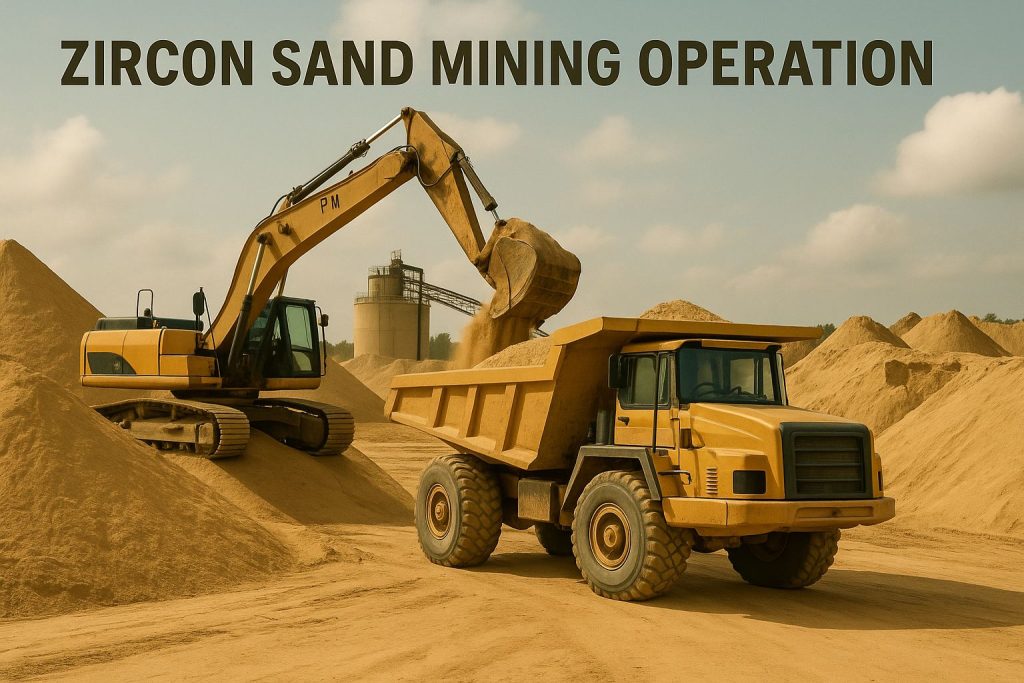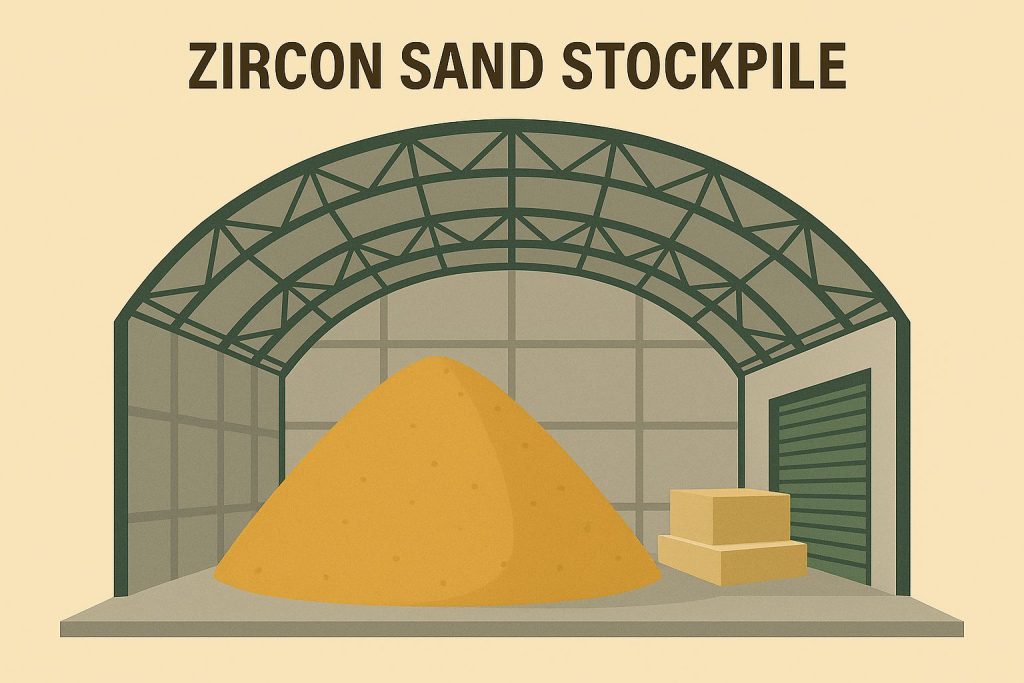Sourcing high-grade zircon sand troubles many companies in ceramics, casting, and refractories. Unstable supply, low purity, or inconsistent shipments often bring costly delays and quality headaches. This article shows clear ways to secure zircon sand you can trust every order. Readers get practical checks, smart buying habits, and up-to-date risk controls that work in busy industrial settings. Global Industry brings insights trusted by buyers worldwide, drawn from real supply chains and verified practices.
Why Should Buyers Trust Zircon Sand Sources?
Many purchasing teams worry about low-quality suppliers cutting corners. Here’s the truth: reliable suppliers follow strict certification and industry standards. They provide steady volume, meet promised specs, and handle paperwork properly.
Trust grows when buyers check if suppliers of zircon sand hold ISO certifications or local mining permits. Some even show third-party lab results on each shipment. This builds confidence and avoids rejections at your site.
Consistency means fewer production stops. If supply drops mid-project, costs skyrocket. Long-term partners help avoid that. They share updates on mining capacity or market swings that affect output.
Always compare multiple suppliers. Ask for past customer references and recent delivery records. If a vendor hesitates, that’s a red flag. Keep contracts clear about delivery timelines, acceptable purity levels, and who pays for failed batches.
Here’s a quick view of trust markers to check:
| Trust Factor | What To Check | Benefit |
|---|---|---|
| Certifications | ISO, local mining licenses | Legal and safe mining |
| Lab Reports | Third-party test results | Confidence in quality |
| References | Past buyer feedback | Real performance proof |

This image shows a certified zircon sand supplier’s site, highlighting secure stockpiles and modern logistics.
How Do You Check Zircon Sand Quality?
Quality testing decides if your final product runs smoothly or fails halfway. Here’s the reality: a single batch of off-spec sand can waste days of labor and burn cash on rework.
Start by knowing which physical traits matter most: particle size distribution, chemical purity, and bulk density. Consistent grain size helps castings and ceramics hold shape under high heat. If particles vary too much, it weakens the mold and can cause defects. Always request a detailed sieve curve, not just an average number.
Chemical checks should focus on the ratio of zirconium dioxide to impurities like iron, titanium, or silica. High impurity levels lower melting point and reduce thermal shock resistance. Trusted suppliers include full X-ray fluorescence (XRF) test sheets for each shipment.
Don’t skip moisture measurement. Excess moisture causes clumping inside storage bags and ruins flow during batching. If your plant runs automatic feeders, lumps clog the lines and slow output. Use oven drying or Karl Fischer titration to verify moisture stays within agreed limits.
Keep this in mind: lab checks should happen before production, not during. Many companies rely only on supplier certificates, but double-checking a small retained sample protects against hidden quality slips.
Consider random spot checks if you buy large volumes. For example, test the first and last pallets in a bulk container. Any big difference could signal poor mixing at the source.
Train your QC team to spot suspicious signs: unusual color, visible lumps, or strange odors. If sand looks off, run full lab tests before mixing it with the main stock.
A quick checklist makes life easier:
| Parameter | Target | Check Method |
|---|---|---|
| Particle Size | 100–200 mesh, uniform | Sieve analysis |
| Chemical Purity | >65% ZrO₂, low Fe/Ti | XRF, wet chemistry |
| Moisture | Below 0.5% | Oven drying |
To wrap up this part, build strong contracts that list acceptable ranges for each property and clear consequences if batches fail. This way, your team can reject bad shipments without disputes. Better safe than stuck with substandard sand clogging your lines.
Where Can Reliable Zircon Sand Be Found?
Supply depends on source location. Let’s get clear: top zircon sand comes from regions like Australia, South Africa, and parts of Southeast Asia. These mines handle large volumes and maintain export-grade processing.
Australian mines are known for tight controls. South Africa offers good reserves but watch local regulations and export permits. Southeast Asia often has smaller producers, so check consistency.
Local sourcing reduces freight cost but may bring mixed purity. Overseas buying brings stable quality but needs clear customs handling. Smart buyers balance local back-up stock with bulk imports.
Here’s a region comparison for quick reference:
| Region | Strengths | Weaknesses |
|---|---|---|
| Australia | High purity, stable laws | Higher shipping cost |
| South Africa | Large reserves, known producers | Export rules change often |
| Southeast Asia | Cheaper rates, closer for Asia buyers | Smaller scale, variable grades |

This photo shows a well-managed mining site, illustrating responsible extraction and steady output.
What Risks Come With Zircon Sand Procurement?
Unexpected risks hide in every step of zircon sand buying. Let’s face it: even the best supplier can’t control every factor, so smart buyers prepare backup plans in advance.
Price swings hit budgets hard. Zircon sand is a mineral commodity. When big mines pause operations for maintenance or stricter local rules cut output, global supply tightens overnight. Prices jump, and smaller buyers feel it first. To ease this pain, many companies sign mid-term contracts with agreed prices for at least six to twelve months. This helps keep per-ton cost steady, even if spot prices spike.
Weather and politics play tricks too. Monsoon season can flood mining areas, stopping excavation for weeks. Strikes at ports or shipping lane blockages cause sudden delays. A single vessel stuck at customs may trap your whole order. Check forwarder reliability and use more than one shipping route when possible.
Freight rates move fast. Global fuel costs, container shortages, or new trade tariffs all push logistics bills up or down. Buyers often forget to add a margin for these surprises, ending up over budget when vessels get rolled to later sailings.
Hidden costs creep in from poor packing and handling. If your sand arrives with ripped bags or contamination, you must rework it or reject the lot. Both options cost time and storage fees.
Here’s a common scenario: a buyer chooses a cheaper supplier overseas but skips insurance to save a few cents per kilo. Then the container gets damaged at sea. Without insurance, the loss lands on you. So always budget for cargo coverage—this small cost saves thousands during accidents.
Watch your payment terms. Some suppliers demand 100% upfront for first orders. If quality fails or shipment delays, getting refunds can be a nightmare. Good practice is splitting payments: partial advance, balance after inspection or safe arrival.
Stay ahead of risk by drafting clear contracts. Define delivery windows, acceptable purity ranges, and what happens if goods arrive late or fail inspection. Some buyers include penalty clauses or compensation rates for severe delays.
This table sums up main procurement risks and how to manage them:
| Risk Type | Common Example | How To Reduce It |
|---|---|---|
| Price Spike | Mine shutdown boosts cost | Fixed-price contracts, multiple suppliers |
| Weather / Politics | Port strike halts shipping | Alternative ports, diverse routes |
| Freight Surprise | Sudden fuel price rise | Buffer in budget, reliable forwarder |
| Quality Problem | Dirty or mixed-grade sand | Pre-shipment inspection, supplier audits |
| Payment Trouble | Advance paid, shipment delayed | Split payment terms, local escrow |
Practical tip: keep a small local emergency stock for sudden supply breaks. Even a month’s worth of backup sand can save an entire production line from grinding to a halt while you sort out a new shipment.
Lastly, train your team to flag new risks early. Markets shift fast, and the sooner you spot a red flag—like sudden mine closures or political news—the faster you can adapt your buying plan.
How Should Zircon Sand Be Stored Safely?
Poor storage turns good sand into wasted money. Pay attention: moisture and contamination cause lumps or chemical changes.
Keep sand in dry, covered sheds. Use sealed bins if your climate is humid. Stack bags on pallets, never on bare floors. Rotate stock by using older batches first. This stops hidden clumping inside bulk bags.
Trained staff should check moisture monthly. If lumps show up, break and sieve before use or reject the batch if specs fail. Avoid over-ordering beyond three months’ usage unless storage controls are strong.
Workers must wear masks to avoid inhaling fine dust. Sand moving equipment needs guards to prevent spills.
Quick storage checklist:
| Tip | Why It Matters |
|---|---|
| Dry, covered area | Stops moisture absorption |
| Pallets under bags | Avoids floor damp |
| Rotate stock | Keeps batches fresh |
| Monthly checks | Catches issues early |
How To Negotiate With Zircon Sand Suppliers?
Solid negotiation keeps your spending lean and your supply chain steady. Here’s how smart buyers get better deals without burning bridges:
Start by gathering real data. Request detailed quotes from at least three suppliers for the same grade and volume. Break down each quote into unit cost, freight, insurance, taxes, and any hidden fees. This helps you spot price padding or unclear terms fast.
Volume matters a lot. Bigger orders often unlock tiered pricing. If you run multiple plants, combine their monthly demand into a single purchase contract. Suppliers prefer steady, predictable buyers. In return, they might offer better rates and priority when stock runs low.
Payment terms protect both sides. Many new vendors ask for 100% upfront. That’s risky for you. Counter with a split model: 30% deposit when signing, the rest after inspection or on safe arrival. This gives you leverage if goods arrive late or off-spec. Trusted partners may even agree to net-30 or net-60 terms after a few orders.
Quality and delivery must go into the contract. Specify acceptable purity ranges, packing methods, and shipment deadlines. Add clear penalties for late delivery or failed tests. Small fines or discounts motivate vendors to stick to promises.
Long-term relationships pay off. Schedule quarterly review calls with your account manager. Use them to discuss price trends, capacity updates, or upcoming maintenance at the mine. Early info lets you plan backup supply or secure extra stock before a crunch.
Communication style matters too. Be firm but fair. Avoid pushing too hard on price if that means the supplier cuts corners on grade or delays shipments. A reasonable margin keeps both sides healthy and ensures steady supply.
Also, watch for currency risks. If you buy from overseas, exchange rates can swing fast. Consider contracts in your local currency or use a hedging service if volumes are big.
If you’re new to a region, ask for small trial shipments first. Check if the supplier packs bags properly, meets customs rules, and handles transport documents right. A few small orders reveal hidden gaps before you commit big capital.
Negotiation snapshot to remember:
| Key Element | Practical Tip |
|---|---|
| Quote Comparison | Always compare three or more offers |
| Order Bundling | Combine plants to raise volume |
| Payment Terms | Use partial upfront + balance later |
| Quality Clauses | Define specs, testing, penalties |
| Relationship | Hold regular review calls |
Keep clear notes of every agreement. Email summaries help fix misunderstandings early. If a supplier changes reps, new staff can see your history and respect agreed terms.
To wrap this up, remember this rule: the best deal balances price, trust, and performance. Pushing too low may backfire in hidden ways. A fair, well-documented deal keeps your line fed with stable, clean zircon sand for years to come.
What Are Sustainable Sourcing Methods?
Responsible companies care about where raw material comes from. Good news: sustainability doesn’t mean higher cost if planned wisely.
Certified mines follow rules on land rehabilitation, fair wages, and safe waste disposal. Some suppliers hold global green certificates proving ethical work.
Ask vendors about tailings management. Poor handling damages local rivers or soil. Support firms with clear environmental audits.
Buyers often include green sourcing in corporate responsibility reports. It helps win deals with clients who value sustainability.
Key points for sustainable sourcing:
| Aspect | What To Look For |
|---|---|
| Eco Certification | Third-party green seal |
| Local Community | Fair wages, safe conditions |
| Tailings Management | Clean disposal process |

A modern storage yard protects sand from weather and keeps purity stable.
How To Handle Zircon Sand Waste?
Unused sand must never enter drains. Here’s the fix: plan waste streams carefully.
Used sand often contains binders or metal traces. Some plants reuse it in low-grade castings. Others sell to construction firms for backfill.
Local rules vary. Always check city or national laws for mineral waste. Some regions need proof of safe disposal or recycling.
Keep bins marked for clean scrap vs. contaminated. Train staff to separate correctly. Partner with certified waste handlers for transport.
Waste handling snapshot:
| Method | Benefit |
|---|---|
| Reuse | Cuts raw material costs |
| Reprocess | Lowers new purchase needs |
| Certified Disposal | Legal compliance |
How To Ensure Safety During Handling?
Safety skips cost more later. Focus here: zircon sand dust irritates lungs if inhaled long term.
Workers must wear respirators and gloves. Use enclosed conveyors or hoppers to control spills. Wetting sand slightly can cut airborne particles.
Emergency plans help in case of large spills. Keep fire exits clear as bulk bags block pathways easily.
Hold training every quarter. Walk staff through handling tools, signs, and reporting small hazards.
Safety must-haves:
| Item | Purpose |
|---|---|
| Masks | Protect lungs |
| Gloves | Prevent skin irritation |
| Wetting | Less dust |
How To Evaluate A New Zircon Sand Supplier?
Adding a new supplier lowers risk. Don’t rush this: check history, samples, and real client reviews.
Visit facilities if possible. Look for organized storage, clean stockpiles, and proper bagging lines. Unclean yards mean sloppy shipments.
Request small batches to test in your process. Check how long delivery takes. Audit paperwork for taxes and customs accuracy.
Interview past clients if allowed. Verify on-time performance and honesty in grading.
New supplier checklist:
| Step | What To Do |
|---|---|
| Facility Visit | Inspect storage and packing |
| Sample Test | Run small batch |
| Client Check | Ask past buyers |
Conclusion
Reliable zircon sand keeps your production steady and quality high. Smart checks, fair contracts, and safe storage protect your business. Global Industry helps buyers match with trusted sources and manage risks. Ready to strengthen your supply chain? Connect with our specialists today to secure top-grade zircon sand for every order. Build stable output and peace of mind with Global Industry at your side.
FAQ
Q1: How often should zircon sand be tested?
Regular testing for each shipment is essential to catch problems early and maintain smooth production processes. It’s advised to conduct at least a quality check for every delivery, especially if there’s a change in supplier or source. Additionally, periodic in-house testing can help ensure consistency in quality before the sand is put to use.
Q2: What certifications prove a zircon sand supplier is reliable?
Certifications such as ISO 9001 for quality management systems, valid mining permits, and comprehensive lab reports greatly enhance a supplier’s credibility. Furthermore, adherence to environmental standards and participation in responsible sourcing programs can indicate reliability. A transparent supply chain with traceability also builds trust with clients.
Q3: Can zircon sand be reused in production?
Many plants successfully reuse zircon sand after proper cleaning and conditioning, effectively lowering the costs associated with purchasing fresh material. This process not only conserves resources but also minimizes waste. However, it’s crucial to monitor the quality and performance of reused sand to ensure it meets production specifications consistently.
Q4: What safety gear do workers need when handling zircon sand?
Workers should wear appropriate personal protective equipment (PPE) such as masks to avoid inhaling dust, gloves to protect their hands from skin irritation, and protective suits to cover their bodies, especially if they are working in environments with high dust concentrations. Eye protection like goggles should also be used to prevent dust from entering the eyes. Adequate ventilation in work areas is essential to further ensure safety.
Q5: What impacts zircon sand prices the most?
Zircon sand prices are primarily influenced by changes in mining output, shipping rates, and demand from foundries and other industries. Fluctuations in global demand, geopolitical factors affecting mining regions, and variations in production costs also play significant roles. Additionally, currency exchange rates can impact prices, especially in international trade scenarios. It’s essential for buyers to stay informed about market trends to make cost-effective purchasing decisions.





